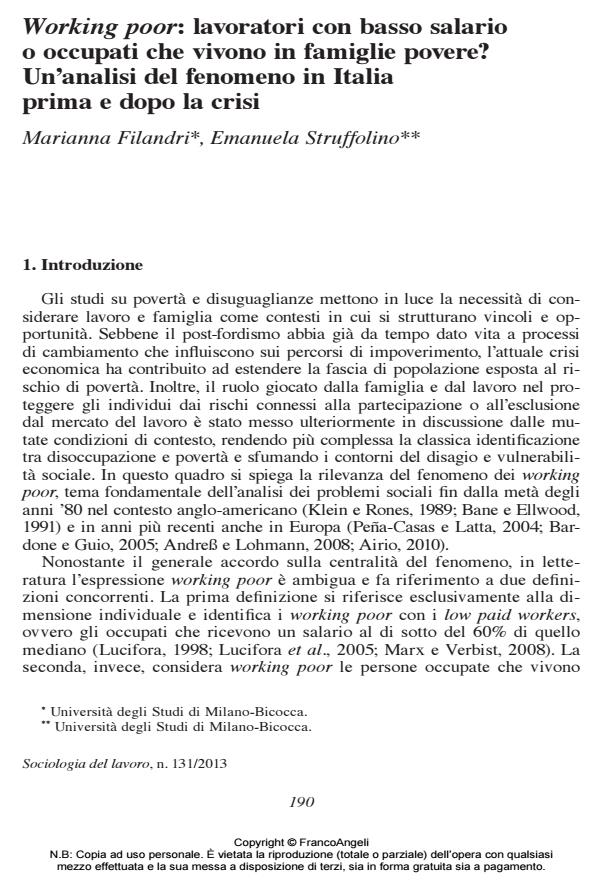Working Poor: Low-paid Earners or Workers living in Poor Households? Evidence Before and After the Crisis in Italy
Journal title SOCIOLOGIA DEL LAVORO
Author/s Marianna Filandri, Emanuela Struffolino
Publishing Year 2013 Issue 2013/131
Language Italian Pages 16 P. 190-205 File size 813 KB
DOI 10.3280/SL2013-131012
DOI is like a bar code for intellectual property: to have more infomation
click here
Below, you can see the article first page
If you want to buy this article in PDF format, you can do it, following the instructions to buy download credits

FrancoAngeli is member of Publishers International Linking Association, Inc (PILA), a not-for-profit association which run the CrossRef service enabling links to and from online scholarly content.
Since the Eighties, the definition of working poor it has been used to study, on the one hand, the population of low paid workers and, on the other hand, earners who receive a (relatively) good salary but live in poor households. However, few studies have been conducted on the intersection of the two competing definitions. The aim of the paper is twofold. In order to provide a deeper understanding of the relationship between the individual and the familiar levels, firstly we wonder if the different definitions identify distinct subpopulation of workers at risk of poverty. Then we consider weather and to what extent the role of individual and familiar variables determining the likelihood to be a working poor according to the diverging definitions has changed after the crisis of 2008. The analysis on Eu-Silc cross-sectional data (European Statistics on Income and Living Conditions, waves from 2005 to 2010) reveal that pointing out alternatively the individual level rather than the familiar one lead to distinguish heterogeneous subpopulations exposed to distinct risk of poverty. However, the phenomenon seems to have structural features that endure despite the crisis.
Keywords: Working poor, household poverty, low wage, labour market, crisis, Eu-Silc
- Proposta per una valutazione di efficacia delle politiche di reinserimento lavorativo Roberto De Vincenzi, in RIV Rassegna Italiana di Valutazione 56/2014 pp.280
DOI: 10.3280/RIV2013-056013 - Povertà e ricchezza tra le famiglie di lavoratori in Italia: trent'anni di svantaggio cumulativo Marianna Filandri, Emanuela Struffolino, in SOCIOLOGIA DEL LAVORO 161/2021 pp.97
DOI: 10.3280/SL2021-161006 - Being Working Poor or Feeling Working Poor? The Role of Work Intensity and Job Stability for Subjective Poverty Marianna Filandri, Silvia Pasqua, Emanuela Struffolino, in Social Indicators Research /2020 pp.781
DOI: 10.1007/s11205-019-02174-0 - Family demographic processes and in-work poverty: A systematic review Antonino Polizzi, Emanuela Struffolino, Zachary Van Winkle, in Advances in Life Course Research 100462/2022 pp.100462
DOI: 10.1016/j.alcr.2022.100462 - Social dialogue in defence of vulnerable groups during the COVID-19 pandemic: comparative analysis of Italy and Spain Francesco Seghezzi, Stefania Negri, Valeria Virgili, Lavinia Serrani, in Transfer: European Review of Labour and Research /2025 pp.365
DOI: 10.1177/10242589251350103 - Lavoratori o lavoratrici povere? Disuguaglianze di genere nel mercato del lavoro in Europa Marianna Filandri, Emanuela Struffolino, in SOCIOLOGIA E RICERCA SOCIALE 118/2019 pp.67
DOI: 10.3280/SR2018-117004 - Increasing work intensity to improve economic well-being: an analysis across European countries Claudia Colombarolli, in European Societies /2025 pp.752
DOI: 10.1162/euso_a_00037 - Care economy e strategie tardo-liberali. I professionisti della cura nella municipalità 3 di Napoli Stefania Ferraro, in SOCIOLOGIA DELLA COMUNICAZIONE 48/2014 pp.76
DOI: 10.3280/SC2014-048008 - Individual and household in-work poverty in Europe: understanding the role of labor market characteristics Marianna Filandri, Emanuela Struffolino, in European Societies /2019 pp.130
DOI: 10.1080/14616696.2018.1536800 - Are the in-work poor more disadvantaged in urban areas? An analysis of housing affordability in Italy Claudia Colombarolli, in Housing Studies /2025 pp.1732
DOI: 10.1080/02673037.2024.2369144 - Lavoratori e famiglie straniere in Italia negli anni della crisi: profili di rischio e divisione di genere del lavoro Eugenia De Rosa, Elisa Marzilli, in MONDI MIGRANTI 3/2017 pp.131
DOI: 10.3280/MM2016-003009 - La configurazione spaziale delle politiche sociali in alcune aree del disagio napoletano Stefania Ferraro, in SOCIOLOGIA URBANA E RURALE 111/2017 pp.117
DOI: 10.3280/SUR2016-111008
Marianna Filandri, Emanuela Struffolino, Working poor: lavoratori con basso salario o occupati che vivono in famiglie povere? Un’analisi del fenomeno in Italia prima e dopo la crisi in "SOCIOLOGIA DEL LAVORO " 131/2013, pp 190-205, DOI: 10.3280/SL2013-131012